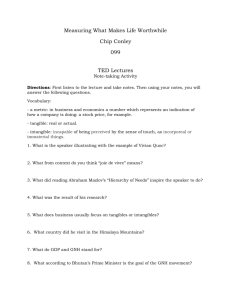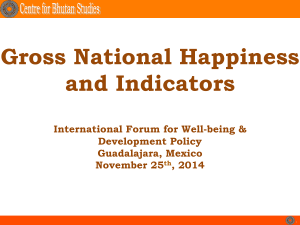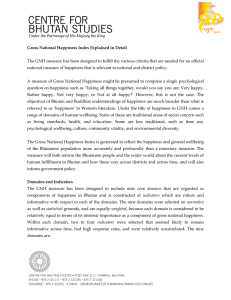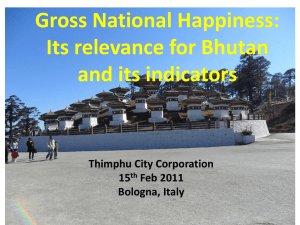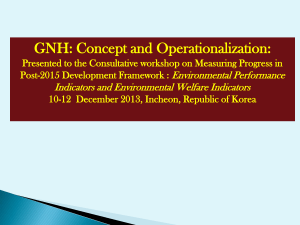Gross National Happiness (GNH) & its Indicators
advertisement
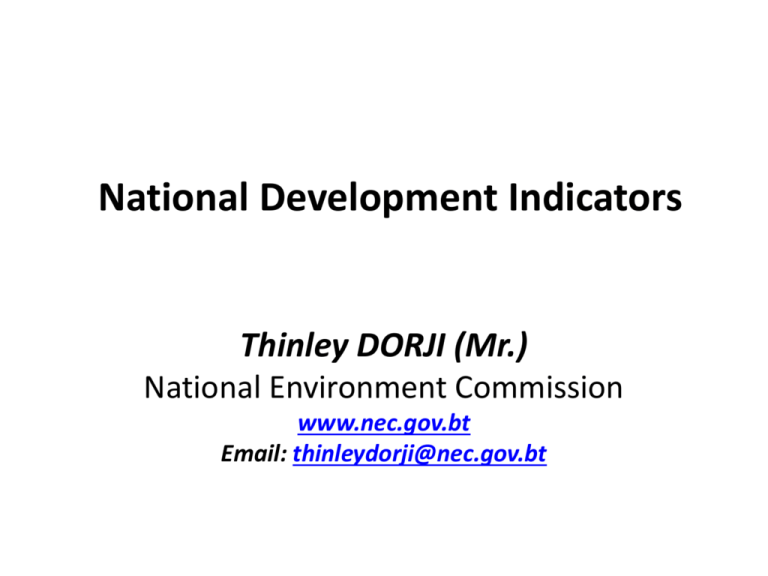
National Development Indicators Thinley DORJI (Mr.) National Environment Commission www.nec.gov.bt Email: thinleydorji@nec.gov.bt Bhutan – country background Area = 38,394 sqkm Population = 0.7m Forest cover = 72% approx Arable land = 2.93% (1125 sqkm) Government = Constitutional democracy Gross National Happiness (GNH) & its Indicators Historically Bhutan is referred to as “Lhomenjong” – valley of medicinal herbs Development philosophy is centered around the Gross National Happiness (GNH) concept (the term coined by His Majesty the Fourth King of Bhutan is early 1970s) GNH concept implies that SD to progress in a manner giving equal importance to non-economic aspects of wellbeing (good life) Gross National Happiness (GNH) & its Indicators • Four pillars of GNH 1. 2. 3. 4. Good governance Sustainable socio-economic development Cultural preservation Environmental conservation • The four pillars of GNH are further classified into 9 domains with 33 indicators (124 variables) GNH indicators • The 33indicators under the nine domains aim to emphasize different aspects of wellbeing and different ways of meeting these underlying human needs – the indicators are further composed of 124 variables • The indicators are: – – – – – Statistically reliable Normatively important, Accuracy across time Policy relevance Clarity of interpretation Psychological Wellbeing Living Standards •Assets •Housing •Household per capita income •Life satisfaction •Positive emotions •Negative emotions •Spirituality Health •Mental health •Self reported health status •Healthy days •Disability Ecological Diversity and Resilience •Ecological Issues •Responsibility towards environment •Wildlife damage (Rural) •Urbanization issues GNH Community Vitality Time Use • • Work Sleep Education •Donations (time & money) •Community relationship •Family •Safety •Literacy •Schooling •Knowledge •Value Good Governance •Gov’t performance •Fundamental rights •Services •Political Participation Cultural Diversity and Resilience •Speak native Language •Cultural Participation •Artistic Skills •Driglam Namzha GNH Index • GNH Index uses two types of thresholds 1. Sufficiency Thresholds: Shows how much a person needs in order to enjoy ‘sufficiency’ – how much is enough, normally, to create a happiness condition. Each of the 33 GNH indicators has a sufficiency threshold. 2. Happiness Threshold: A person who enjoys sufficiency in more than six or more of the 9 domains is considered happy. What it does? • All government polices & plans are screened for GNH (mandatory mainstreaming of environmental issues into plans, policies & programs) • All development projects/activities should be aligned with the GNH approved/endorsed plans • Quarterly review is conducted to measure progress & status What it does? • GNH survey conducted and based on the results measures are taken to improve the GNH Index. • GNH Index effectively classifies the population depending on the degree of happiness (in sufficiency) – – – – Deeply happy (>77%) Extensively happy (66% - 76%) Narrowly happy (50% - 65%) Unhappy (0 %– 49%) GNP ≠ GNH “Gross National Happiness (GNH) measures the quality of a country in more holistic way [than GNP] and believes that the beneficial development of human society takes place when material and spiritual development occurs side by side to complement and reinforce each other” Tashi Delek & Thank You for listening
